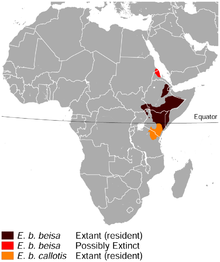Fringe-eared oryx
| Fringe-eared oryx | |
|---|---|
 |
|
| Scientific classification | |
| Kingdom: | Animalia |
| Phylum: | Chordata |
| Class: | Mammalia |
| Order: | Artiodactyla |
| Family: | Bovidae |
| Subfamily: | Hippotraginae |
| Genus: | Oryx |
| Species: | O. beisa |
| Subspecies: | O. b. callotis |
| Trinomial name | |
|
Oryx beisa callotis Thomas, 1892 |
|
 |
|
| Fringe-eared and common oryx ranges. | |
| Synonyms | |
|
Oryx callotis, Thomas 1892 |
|
Oryx callotis, Thomas 1892
The fringe-eared oryx (Oryx beisa callotis) is a subspecies of East African oryx. It was originally described as a distinct species by Oldfield Thomas in 1892, but was subsequently re-evaluated as a subspecies by Richard Lydekker in 1912. Recently, analysis using the phylogenetic species concept has led some authors to conclude that it should be returned to full species status (Oryx callotis).
Fringe-eared oryxes are relatively muscular antelopes with short, slender legs. Adults are 153 to 170 cm (60 to 67 in) in head-body length, with a tail 45 to 50 cm (18 to 20 in) long, and stand 110 to 120 cm (43 to 47 in) tall at the shoulder. Males are heavier, weighing 167 to 209 kg (368 to 461 lb), compared with 116 to 188 kg (256 to 414 lb) for females, but the two sexes are otherwise difficult to distinguish. The hair is fawn coloured across almost the entire body, with a black stripe down the flanks. There are also black bands on the front and side of the face, and down the throat, while the muzzle is white. There is a short mane of brownish hair, as well as tufts of black hair above the hooves, at the end of the tail, and on the ears. It is from the last feature, unique among the various kinds of oryx, that the subspecies gains its common name.
The horns are 76 to 81 cm (30 to 32 in) long, and almost straight, with only a slight backwards curve. Unlike in most other hippotragine antelopes, but like those of other oryxes, those of the fringe-eared oryx are parallel with the upper surface of the animal's snout. The horns are similar in males and females, and have an average of sixteen rings around the lower half, before smoothly tapering to a point.
Fringe-eared oryxes are found only in southeastern Kenya and northeastern Tanzania. Although previously not found within the present-day boundaries of the Serengeti National Park, herds of oryx began moving into that area in 1972, where they still remain. They inhabit semi-arid grasslands, scrubland, and Acacia woodland, being most common in areas with an annual rainfall of 40 to 80 centimetres (16 to 31 in) per year. Predictions by the IUCN indicate that they may soon become restricted to national parks and similarly protected areas, due to pressure from poachers and habitat loss due to agriculture outside such areas.
...
Wikipedia

